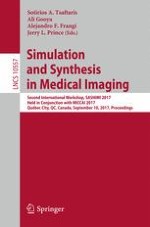2017 | Buch
Simulation and Synthesis in Medical Imaging
Second International Workshop, SASHIMI 2017, Held in Conjunction with MICCAI 2017, Québec City, QC, Canada, September 10, 2017, Proceedings
herausgegeben von: Sotirios A. Tsaftaris, Ali Gooya, Prof. Alejandro F. Frangi, Jerry L. Prince
Verlag: Springer International Publishing
Buchreihe : Lecture Notes in Computer Science
